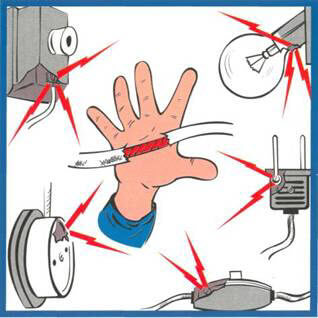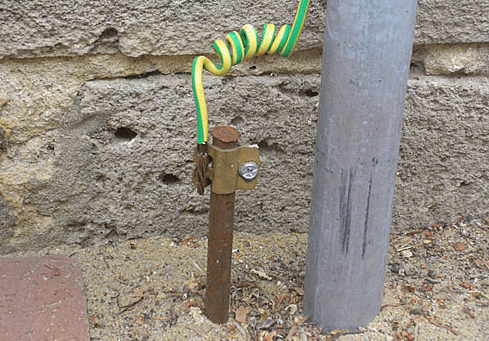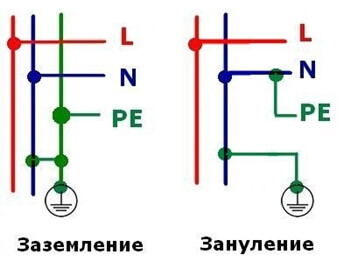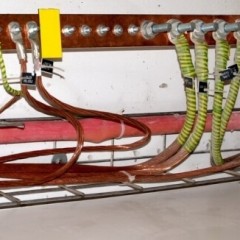What is the difference between grounding and protective grounding?
The main differences
Both the first and the second protection systems perform the same function - protecting a person from electric shock when touching a bare wire or an electrical appliance on which current leak. The only difference is that protective grounding provokes an instantaneous power outage in case of a dangerous contact between a person and a wire, and grounding instantly removes dangerous voltage to the ground. It also causes a decrease in the voltage of nullified metal non-conductive parts that are energized relative to the ground. This is their general difference from each other, in a nutshell.
If we consider the issue in more detail, then we need to focus on what the principle of operation of each protection option is, on the basis of which the difference in alternative options will be immediately visible. Grounding works as follows: a grounding wire is connected to the housing of hazardous electrical appliances and household appliances, which goes to the grounding bus in the distribution panel. From there, the common ground conductor goes to the main ground loop - a metal structure, dug in the ground near the house (as shown in the photo). If there is a breakdown of the current to the device body or contact with a bare current-carrying conductor, the danger will pass the person.
As for the grounding, it is a connection of the body of the appliance with the neutral wire of the network - zero. The result is a closed loop, as shown in the diagram below. When a dangerous situation occurs short circuit and circuit breakers on the input panel will instantly turn off the electricity.
You can clearly see the difference between grounding and grounding in this diagram:
We hope that now it has become clear to you how the two defense systems differ and what is equally important - how they work. We also recommend viewing the difference between them in a visual video example:
What's better?
In order for you to fully understand the material, first we will provide differences in the use of each system, on the basis of which we will draw our own conclusion.
- Grounding at home can easily be done with your own hands, having a welding machine and a little metal on hand. At the same time, the creation of grounding requires certain knowledge related to calculations and the choice of the optimal point of connecting the wire to the neutral.
- A conductor providing the indicated connections of the occupied parts with dead earthed neutral The source is called the protective conductor.
- The neutral conductor differs from the neutral conductor, which is also connected to a grounded neutral point of the source. It is intended to power the source.
- If happen zero wire break in the distribution panel, the grounding system will not work, and you may become a victim of electric shock. In this regard, with a protective grounding system is easier, because unlike zero, the PE wire does not tear off and practically does not fall off if you tighten the terminal at least once a year. Although about this we can say that the contour of the "earth" due to being on the street can also be damaged over time, especially in places of welding of electrodes. Again, if you are doing an annual audit, there will be no problem.
Based on this, we can draw the following conclusion - proper grounding in a private house It’s not difficult to do it yourself, and besides, such a system is more durable, and therefore safe. As for the grounding, to create it you need to call the master and at the same time a more frequent inspection of the integrity of the neutral wire, which is a huge minus when comparing the differences. This option is not recommended, it is better to connect an RCD for protection. We hope that now you understand the difference between grounding and grounding, how both systems work and which is more effective for home and apartment.
Similar materials:









The author is confused. Both schemes depict grounding (together with re-grounding). The first circuit is of the TN-S type, and the second is of the TN-C-S type. Safety in both schemes is provided by automatic power off (AOP), which in both schemes provides protective grounding. Grounding is installed here, mainly in the event of a broken neutral conductor and is called re-grounding. Please note that in both circuits it is electrically connected to the neutral wire. Protective grounding of open conductive parts (HRE) is carried out only in CT and IT systems.
Any “grounding” in tN is a grounding by definition. The neutral is connected with the earth. Did you re or did not.
Pure grounding is in TT, for example.
TN systems always carry out the grounding of open conductive parts (HRE). There is also grounding, called re-grounding, which is performed at the input when powered by overhead power lines. When powered by a cable line, such re-grounding is not necessary. So grounding and grounding are not the same thing. Consumer electrical installations are grounded at or near the facility. Grounding on the TP ground the current-carrying part of the distribution system: the neutral and the transformer housing, and not the HRE of the consumer's electrical installations. In the old PUE (the 80th year) it was even written that in systems with a grounded neutral (and this is TN systems), it is forbidden to use grounding without grounding (short and clear).
Because grounding without grounding is a TT system. In the phrase "Any" grounding "in tN is a grounding by definition," I meant that the protective conductor in TN is always grounding, it does not matter whether there is re-grounding or not.
In TT systems, the main safety measure is automatic power off - AOP (rather than grounding), which is provided using an RCD.Grounding is a complement and without AOP, electrical safety cannot be provided. Therefore, in TT systems, they are obliged to put an RCD. Grounding of open conductive parts of electrical installations as the only protective measure can be performed only in IT systems. Only in these systems can grounding provide a safe current through a person by touching a conductive body of electrical equipment with broken insulation. But where do you now come across such a system?